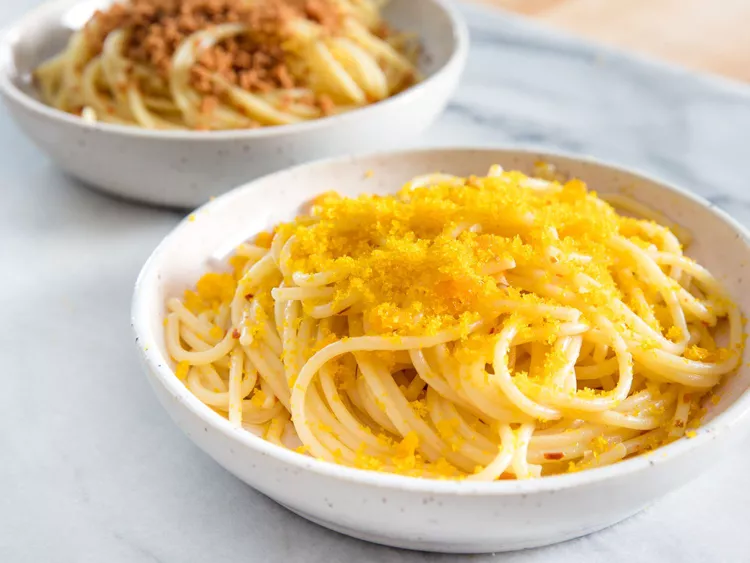It has many names.
Advertisement Banner
It is known as karasumi and served with beer or sake in some izakaya. If you ate eoran with other Korean drinking foods, washed down by a swig soju, it might be called eoran. You might call it by another name: The Greeks call avgotaraho, and the French poutarge. Croatians call it bottarga. This is more similar to the name that most Americans are familiar with, if at all. You may know it by its Arabic name, butarkah. This is where its Italian name comes from.
What is Bottarga?
The product is the same, no matter how you refer to it: Bottarga, or roe, is the sac of fish roe, usually grey mullet. It is salted and massaged, releasing air pockets before being pressed, dried, and then pressed again. This ancient delicacy is enjoyed all over the world. It seems that almost everywhere humans fished they salted and dried the fish roe to create a pantry staple with a rich, savory flavor. Bottarga can be eaten with vegetables or grated on top of almost any grain or starch. It is also delicious when sliced thinly and seasoned with salt, soy sauce, lemon juice, and flavorful oil.
The history of bottarga will be discussed, along with the types available and where you can find them. We will also discuss what to do once you have some. Bottom line: Buy some. Buy some right now! Store it in the refrigerator and use it for special occasions. Treat it as a luxury.
You can also do as I do and use it as much as you budget will allow. Bottarga is a pricey ingredient, but you can use it with countless foods. It’s a great way to add richness and savory flavor to pasta, eggs or other dishes.
Bottarga: A Short History
It is believed that the Phoenicians invented the method of preserving the roe of grey mullet. They then spread the practice to Egypt where, according to reports, the first documented evidence of this practice was found. The phrase “said to have been found” is used because, in many of the explainers and histories about bottarga available online, the claim that an Egyptian mural from the 10th century BCE depicting fishermen preparing sacs roe is often recycled. Many people believe that Egypt was the source of bottarga in the world, as the word “bottarga,” which is derived by the Arabic word “butarkhah,” is Coptic.
According to Andrew Dalby – a linguist and historian – the origins of the word is a bit more complex. Dalby writes that the Greeks colonized Byzantium around 600 BCE. The Greeks enjoyed bottarga. In Tastes of Byzantium, The Cuisine of a Legendary Empire he states that “along with all the seafood delights of classical Greece, Byzantines also enjoyed salted graymullet roe and ootarikhon, literally ‘egg-pickle’. This Greek word is the origin of Coptic outarakhon, Arabic butarkhah, and the modern term botargo ‘),”, which seems to indicate the Greeks are the ones
It is discussed in Libro de Arte Coquinaria, a book of medieval Italian cookery written around 1465 by Martino de Rossi, who has been called “the prince of chefs” or, more dismally, “the world’s first celebrity chef”. The first ever cookbook, De honesta voluptate and valetudine by Bartolomeo Sacchi, discusses bottarga. It was written by Martino De Rossi in Libro De Arte Coquinaria in 1465. The prince of chefs describes how to make bottarga: use very fresh roe and cure it with sea salt. Press it then dry. He also offers a note about how to eat the product.
Samuel Pepys’ detailed diary, which has given historians a glimpse of England in the second half of the 17th century, includes a mention of bottarga as part of an account of a pleasant summer evening. The entry for June 5, 1661 reads: “So I went home with Sir William, and being very hot, I took my flageolette, and played on the leads in our garden, where Sir W. Pen was in his shirt and leads. And there we sat talking and singing and
All of which, I mention merely to highlight that it is enjoyed since centuries from Byzantium through Rome to London and beyond.
Bottarga comes in many different varieties
There are some differences between the bottarga-like products of different cultures: The Greeks appear to coat their avgotaraho in beeswax, which acts as a preservative; karasumi produced in Japan and Taiwan is not dried as thoroughly and, therefore, is a little softer. (It’s often covered with wax to prevent further drying). Different cultures produce bottarga in different ways. The Greeks coat their avgotaraho with beeswax as a preservation agent. Karasumi, produced in Japan and Taiwan, is less dried than Italian bottarga and therefore softer. It is also often covered in wax in order to prevent further drying. Eoran is the Korean version. It is made from cured and dried gray mullet roe. The roe is then cured with soy sauce and brushed in sesame oil while it dries.
Bottarga di Tonno is another variety that deserves to be mentioned. It’s made from tuna roe sacs. The bottarga from grey mullet has a more delicate flavor (read: less fishy). However, in the United States the tuna bottarga is much harder to find and more expensive. It’s also a little softer, making it harder to grate with a Microplane. (Popping it into the freezer helps).
The bottarga from mullet is subtly salted, and has a hint of fishiness that you would taste in uni or caviar. The bottarga from tuna has a stronger salinity, a more intense dried fish flavor and a mineral edge. Of course, tastes vary, but I personally prefer the tuna roe bottarga.
Bottarga: Where to buy?
Bottarga, a specialty product, is only available in Italian specialty shops or online. Amazon has a wide selection. Eataly’s two New York City locations regularly carry bottarga. Specialty shops such as Un Posto Italiano also regularly stock it.
I buy and use Sardinian Mullet Bottarga, imported by Gustiamo. You can order it through Amazon or directly from Gustiamo. Gustiamo, to my knowledge, is the only importer in the United States of tuna-roe bottarga. However, it is significantly more expensive at $57 per four ounces.
Gustiamo Whole Mullet Bottarga
Buy on Gustiamo.com
Bottarga is best grated freshly, just like hard cheese. In the context of cheeses, I think it’s best to compare bottarga with premium products such as Parmigiano-Reggiano. While a pound Parmigiano is usually priced at $20, it will serve the same number of pasta plates as four ounces bottarga.
How to Store and Use Bottarga
The best thing about bottarga, aside from its taste, is that it can be stored indefinitely. After you peel off the pellicle and grate a little over pasta, any remaining bottarga will stay in the fridge for many months, wrapped tightly in plastic.
This pellicle is the membrane which encapsulates the sac of roe, and it becomes papery as the process of drying and curing continues. It isn’t necessary to remove the pellicle, but it is preferred. Andrew Feinberg writes in Franny’s Simple, Seasonal Italian that if you do not peel it, “it could get caught in your mouth.” I generally peel as much as I need, similar to certain salamis with unpleasantly chewy casings.
After peeling, you can use it however you like. It can be used as a finishing element, grated finely or crumbled, over a variety of dishes, or eaten on its own in thin slices with some olive oil, lemon juice, and salt. You can choose to go the Middle Eastern or Asian route. It has been enjoyed all over the world for centuries because of its versatility.
Here is a list of some suggestions. It’s great grated over pasta. Especially in simple preparations like aglio and olio, or my favorite pasta-bottarga combo, pasta al lime. Italian purists like Sasha Marx will not agree with grating the bottarga on any pasta. There is a special pasta dish called, what else?, pasta con la bottarga. I’m not an Italian purist or purist at all! It’s a great addition to the humble boiled eggs, whether they are hard-boiled or soft-boiled. It also makes a tasty topping for tamago-kaki-gohan, and it goes well with plain steamed rice.
Only one caution: do not cook bottarga. Martino suggests that you can warm it gently, but it’s a waste if, for example, you saute grated Bottarga with a Sofrito.
If that’s not possible, you can do whatever you want. You can put it over mashed potatoes or grated it over broiled broccoli, or you can, as a New York chef was known to do, add it to beef tartare. The sky’s the limit.


